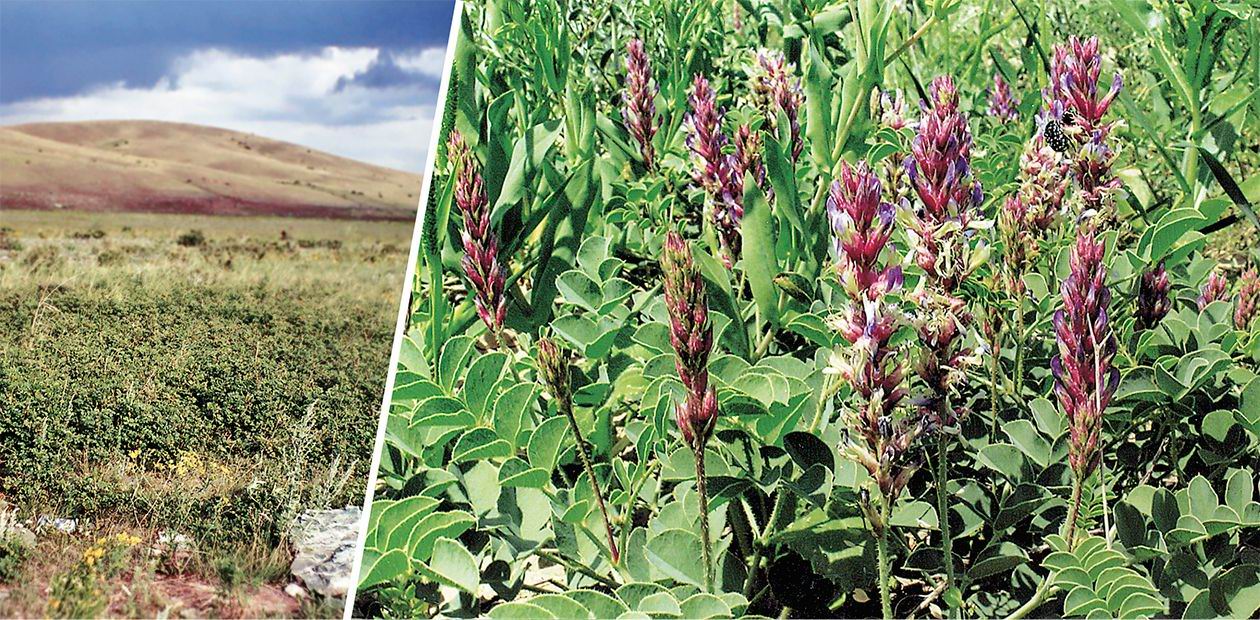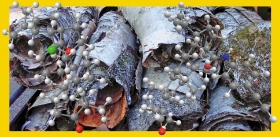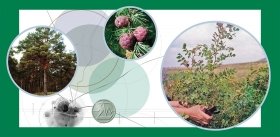Sweet Scythian Root
Licorice (or peavine) is one of the most ancient medicinal plants known to man. Chinese medicine has used the licorice root since the third millennium B.C. and still values it, along with the legendary ginseng. The licorice root was applied successfully by the ancient Indian, Japanese, and Tibetan healers, as well as by the medical practitioners of ancient Greece. They used to dig licorice roots within the territories of the present-day Central Asia and Kazakhstan, in the flood-lands of the Amu- Darya River and the Ural River, in the south of Russia, and in China
It takes a horse-rider twelve days to deliver
the sweet Scythian root glykys.
Theophrastos, ancient Greek philosopher (4th—3rd c. BC)
Different languages gave this plant with sweet roots names reflecting this very quality: gan’-tsao (“sweet plant”) in Chinese, maduko (“sweet”) in Sanskrit, sladunek (“sweet”) in Bulgarian, solodka (Old Russian for “sweet”) in Russian, and licorice in English. The formal Latin name is Glycyrrhiza, which derives from the Greek glykos (“sweet”) and rhiza (“root”).
From Turkmenistan to Siberia
Modern botany includes 45 species in the licorice genus. Researcher with the Central Siberian Botanical Garden, V. P. Grankina distinguishes two subgenera: the authentic, or sweet, licorice and non-sweet licorice. We will focus on the former subgenus.
The most widely-spread species of sweet licorice are Glycyrrhiza glabra (“Spanish/common licorice”), Glycyrrhiza uralenis (“Ural licorice”), Glycyrrhiza korzinsky (“Korzhinsky licorice”), and Glycyrrhiza vzdutaya (“puffed licorice”). They abound in Eurasia, occupying huge habitats, especially the two former species.
The main Tibetan guide Dzhudshi indicates that licorice “nourishes, makes one look a picture of health, and contributes to a long life and better condition of the six senses”Glycyrrhiza glabra, a plant with massive roots, is very widely spread in Turkmenistan and Kazakhstan. Here you can come across licorice plants whose roots, up to 10—12 centimeters in diameter, are hundreds of meters long and go dozens of meters deep! In the former Soviet Union, the Turkmen town of Chardzhow supplied over 1,500 tons of Glycyrrhiza glabra’s dry roots to the Russian town of Uralsk, which was the main site of the licorice extract production. The roots were largely collected in the flood-lands of the Amu-Darya River.
Western Kazakhstan, Ural oblast (“region”) and Atyrau (former Gurievsk) oblast are especially rich in licorice. The famous naturalist, Academician P. S. Pallas (1741—1811), who traveled around these places in the early 19th century, wrote: “I saw a spiky licorice tree for the first time three versts (a Russian unit of distance equal to 0.6629 mile) from the town of Yaitsk, and as I was going along the Yaik River, I saw more of them. From Buradin, the earth becomes salty, with lots of stone tea and, above all, ordinary licorice trees.” In the 1960s, prominent Soviet botanists believed that in Western Kazakhstan it was ecologically feasible to stock up 7,000 tons of licorice roots a year!
Russia, though ranking below Turkmenistan and Kazakhstan, also has sizeable stocks of the licorice roots, which grow the flood-lands of the Lower Volga, in Kuban, Dagestan, and in the Orenburg oblast.
West Siberian steppes abound in the Ural licorice, or Glycyrrhiza uralenis DC, which one can see on alkaline soils, next to the roads and along forests’ borderlines. Thickets in the south of the Krasnoyarsk krai (“region”) can be of industrial interest. In the South Urals, there grows Glycyrrhiza korzhinski, actively conquering the wasteland that used to be fertile agricultural land.
Dolce renaissance
It is not accidental that we have dwelt in such detail on the licorice distribution in nature. Undoubtedly, the list of licorice-based traditional medicine recipes of the peoples inhabiting Eurasia is very impressive. Of greater interest to us though is renaissance of this ancient drug, which has occurred in the last three decades.
The current world market of the licorice root amounts to tens thousands tons a year. Japan alone, traditionally strongly inclined to the sweet root, purchases about 10,000 tons annually: products containing licorice derivatives are on the daily diet of every citizen of this country. According to U.S. nutritionists, every day we should consume no less that 200 milligrams of glycyrrhizin, the main component of the licorice root.
The licorice root is part of the Russian pharmacopoeia as well. It is recommended as an expectorant and emollient in case of catarrhal diseases of respiratory system, as a regulator of water-salt metabolism, as a gentle laxative, and as a base for many mixtures.
And now it is high time to focus on the licorice components that are responsible for its healing properties. Licorice metabolites are amazingly diverse: triterpene glycosides, sugars, polysaccharides, phenol compounds of various types and a great many other metabolites.
Some scientists believe that licorice is among the most ancient flowering plants (Kruganova, 1965; Baitenov, 1991). Its predecessors, born in the Palaeogene about 70 million years ago, covered a vast expanse in the early Tertian. However, global changes in the environment that took place in the Neogene tore apart the genus habitatTriterpene glycosides and phenol compounds are the main effective components. The two best represented species of the licorice—the Spanish/common licorice and Ural licorice—yield about thirty triterpene glycosides and over a hundred phenol compounds. Importantly, these metabolites largely refer to the so-called minor components, which means that their content in the roots is from one-tenth to one-thousandth per cent.
Both species have a relatively high content of the major component responsible for the sweet taste, namely triterpene glycoside of glycyrrhizic acid. This component and its minor companions constitute the greater part of metabolites with Glycyrrhiza glabra whilst in Glycyrrhiza uralenis phenol substances domineer.
From HIV to Ebola
For the last four decades, glycyrrhizic acid and its derivatives have been brought under close pharmacological and clinical study. Scientific literature on the subject counts several thousand sources and continues to grow.
This licorice metabolite is acknowledged to have an anti-inflammatory, anti-ulcer, anti-allergic, hypolipidemic, anti-sclerotic, and anti-oxidant effect.
Ammonia salt of glycyrrhizic acid (which is the base of the glycyram drug) is used in Russia and some other countries to cure bronchial asthma, allergic dermatitis, and eczema. A valuable quality of the glycyrrhizic acid is its ability to protect liver from toxic substances. For instance, Japan has already developed and used to cure hepatitis injection medicines prepared on the basis of glycyrrhizic acid.
One of the most promising fields of glycyrrhizic acid application is preparations designed to regulate the immune system. News of the glycyrrhizic acid’s ability to inhibit reproduction of the human immunodeficiency virus made a sensation. This has stimulated search for new anti-HIV agents among the glycyrrhizic acid derivatives.
A series of investigations supervised by Academician Genrikh A. Tolstikov (Institute of Organic Chemistry, Siberian Branch, Russian Academy of Sciences, Novosibirsk) and Professor Andrey G. Pokrovsky (Vector State Research Center, Koltsovo, Novosibirsk oblast) have resulted, among other things, in an anti-HIV drug patented as niglizin, whose anti-virus activity exceeds that of the well-known azidothymidine.
Niglizin, in combination with other medicines, is suggested as the main drug to cure HIV infection. Of special interest is niglizin’s ability to induce interferon gamma. This quality, lacking in other known anti-HIV preparations, boosts the therapeutic potential of the complex drugs that include niglizin. Moreover, scientists of the Vector State Research Center have discovered that niglizin and other derivatives of glycyrrhizic acid are reproduction inhibitors of viruses Marburg and Ebola.
Glycyrrhizic acid derivatives have paved the way to HIV chemotherapy for a host of its “relations” belonging to the class of triterpenoids. A sharp increase in the number of publications devoted to the triterpenoids’ pharmacological properties suggests that a lot of efforts are being made in many countries to involve these compounds in drug development.
Of principal interest are betulin compounds present in the birch bark—their content in this easily accessible raw material is up to 20%. Raw materials of other triterpenoids, though not as widely spread as birch bark or licorice, are nonetheless sufficient to supply a large production of drugs. In Russia, such sources are cranberry pulp and waste products of sea-buckthorn processing as well as some landscape plants that produce biologically active triterpenoids.
A convincing proof that such a production is feasible is furnished by glycyrrhizic acid itself. For instance, carbenoxolone, a drug for quarter of a century considered the best remedy for ulcer (until new generation medicines came into being in the 1990s) was developed in England based on glycyrrhetic acid—the non-saccharine component of glycyrrhizic acid and carrier of its biological activity.
From the poem “On Herbs’ Qualities” by Odo from Men: “Licorice truly has many qualities: it is not too hot, and it is sweet and wet. It will cure the throat of him who suffers from coughing, and heal the chest and lungs, giving them warmth…”In the late 1960s, a set of experiments was carried out under Academician Genrich A. Tolstikov’s supervision with a view to developing new preparations from glycyrrhetic acid. Glyderinin, a drug now produced in Kazakhstan and created by the Academician’s disciple Machmudgan P. Irismetov, is prescribed to cure dermatitis, allergic dermatitis, neurodermatisis, eczema and to heal wounds and burns.
Scientists doing research into chemistry and pharmacological qualities of glycyrrhizic acid are positive that it can be the source of highly efficient immuno-stimulating and psychotropic drugs.
Unique glycyrrhizin
Glycyrrhizic acid features a few fascinating physical-chemical qualities, one of which is its ability to form associates in solutions. This is not much of a surprise: if you look closely at the structure of this metabolite, you will see numerous oxygen-containing polar groupings. Thanks to these groupings, glycyrrhizic acid can bind molecules of drugs, or pharmacons, as they are often called.
Research into the pharmacological properties of several pharmacons injected into the animals’ organisms together with glycyrrhizic acid has produced an unexpected result. For instance, simultaneous injection of the well-known non-steroid anti-inflammatory drugs —like aspirin, voltaren, and butadion—and glycyrrhizic acid has dramatically reduced their toxicity and increased their base activity. What came as a big surprise was virtually complete depression of the far from harmless side effect of pharmacons, erosion of the digestive system.
We called the effect glycyrrhizic acid has on drugs’ pharmacology the effect of glycoside clathrating of pharmacons. What is its nature? As it has been mentioned, glycyrrhizic acid forms associates that have special “niches” for accommodating pharmacon molecules. In chemists’ language, host-guest combinations form, which are referred to as clathrates. The “host” is glycyrrhizic acid, which welcomes its “guest”, a pharmacon molecule. Numerous tests conducted on laboratory animals have shown that the maximum effect is normally produced by the clathrates in which four molecules of glycyrrhizic acid are bound with one molecule of a pharmacon.
In a body, a clathrate behaves like an independent drug with new properties. In particular, interaction with receptors (it is this process that determines the pharmacological effect) involves entire clathrates rather than their separate molecules. Since a pharmacon inside a clathrate is protected against preterm ruin, a considerably lower therapeutic dose of it can be prescribed, which reduces its toxicity.
Clathrate formation with glycyrrhizic acid acting as the host makes it possible to reduce the therapeutic doses of anti-arrhythmia and anti-depression drugs from one-fifteenth to one-twentieth of the quantities prescribed now. In the case of the so-called calcium channel blockers (medicines used to cure hypertonia and coronary disease), the result is even more stunning: it looks like clathrate formation involving licorice metabolite will allow us to prescribe one-hundredth of the pharmacon’s common therapeutic dose!
The clathrating effect, however, does not amount to a reduction of the pharmacon dose. Compounds bound in clathrate manifest new properties as they act together. For example, their interaction with non-steroid anti-inflammatory drugs protects mucous coats from erosion.
An example of the glycoside clathrating effect put in practice is the prostate gland drugs clathyram and prastaglandin developed for animal-breeding and veterinary medicine. The latter drug (much more efficient than its imported analogues) was made in Russia in the early 1990s, and its factory output satisfied a large part of the national agriculture’s demand.
The glycoside clathrating effect, first discovered in glycyrrhizic acid, has also been observed with other vegetative glycosides. For instance, stevioside from the “sweet” Stevia rebaudiana used as a food sweetener is promising for binding pharmacons in clathrates.
Phenols against cancer
Having focused on licorice glycosides, we have left aside its phenol metabolites, which also deserve attention. The first experience of their practical application is licviriton and flacarbin—drugs developed on the basis of phenol compounds extracted from the roots of Glycyrrhiza glabra and Glycyrrhiza uralenis. They are prescribed as remedies for stomach and dodecadactylon ulcer and hyperacid gastritis.
The effect of glycoside clathrating (binding), first discovered by Novosibirsk scientists in glycyrrhizic acid—a licorice metabolite—can be applied in pharmacology to develop drugs with new qualities, on the basis of the medicines knownWhile on the subject of the chemical nature of licorice’s phenol metabolites, let us emphasize again that the content of none of them in the roots is as high as that of glycyrrhizic acid. The content of few of them reaches 1—2%, whilst for most it does not exceed 0.01%.
Nevertheless, these minor components are worthy of investigation: some of them may possess unique qualities. For example, some powerful anti-HIV agents have been detected whose structure is not so much complicated as to rule out their man-made synthesis.
The roots of the three pharmacopoeia species of licorice are used as raw material: Spanish licorice, Ural licorice, and Korzhinsky licorice. When licorice is stored up for industrial purposes in the regions where all the three species grow (in Kazakhstan, for instance), no distinction is made between themMoreover, studies conducted in the last decade have demonstrated that several phenol metabolites of Glycyrrhiza glabra and Glycyrrhiza uralenis (such as licviritigenin) can prevent the formation of malignant tumors. The number of patents maintaining that licorice phenol components can be used as remedies for cancer is increasing.
As compared with 1976 statistics, total area of licorice habitats located within the territory of the former Soviet Union has decreased by almost 40%, and reserves of dry licorice roots have gone down by 45%, amounting today to 180,000 tonsAt the example of just one plant we have tried to show that our national researchers—whose professional standards and achievements are at the level of the world’s best-known academic schools—have done and are still doing everything they can to turn our national flora into a reliable support for the Russian health care system. This is not an easy task, and if some things sometimes go wrong, it is not necessarily the scientists’ fault. This, however, is a subject of a completely different discussion.
References
Grankina V. P. The problem of species and species formation. Tomsk: TGU publishers, 2000. Pp. 38—40
Nadezhdina T. P. On the licorice studies and use in the USSR. Nauka, 1966. Pp. 87—91
Tolstikova T. G., Tolstikov A. G., Tolstikov G. A. On the way to low-dose drugs.//Vestnik RAN, 2007, # 77(10). Pp. 867—874
Nomura T., Fukai T. Progress in chemistry of organic natural products. New York: Springer-Verlag, 1998.—V.73.—Pp. 1—140.
In this publication, we have used illustrations from the monograph “Licorice: Biodiversity, Chemistry, Applications in Medicine” by Tolstikov G. A., Baltina L. A., Grankina V. P., et al. Novosibirsk: Geo Academic Publishers, 2007; 311 p.











